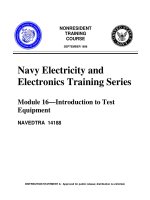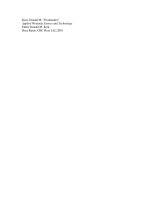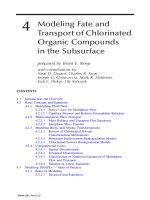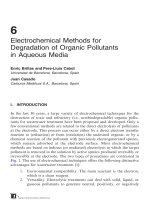PHYSICS 3 (ELECTRICITY AND MAGNETISM) - CHAPTER 3 potx
Bạn đang xem bản rút gọn của tài liệu. Xem và tải ngay bản đầy đủ của tài liệu tại đây (188.37 KB, 8 trang )
Electricity and Magnetism
30
Chapter 3 CURRENT AND RESISTANCE, DIRECT CURRENT CIRCUITS
3.1 Electric Current
1) The electric current in a conductor is defined by
dq
i =
dt
[A] (3.1)
here dq is the amount of (positive) charge that passes in time dt through a hypothetical surface that cuts
across the conductor. By convention, the direction of electric current is taken as the direction in which
positive charge carriers would move. The SI unit of electric current is ampere (A) : 1A = 1C/s.
2) The current i (a scalar) is related to the current density
J
r
(a vector) by
i = JdA
∫
uuur
r
(3.2)
where
dA
uuur
is a vector perpendicular to a surface element of area dA and the integral is taken over any
surface cutting across the conductor.
J
r
has the same direction as the velocity of the moving charges if they
are positive and the opposite direction if they are negative.
3.2 A Model for Electrical Conduction
When a conductor does not have a current through it, its conduction electrons move randomly, with no net
motion in any direction. When the conductor has a current through it, these electrons still move randomly,
but now they tend to drift with a drift speed v
d
in the direction opposite that of the applied electric field
that causes the current. The drift speed is tiny compared with the speeds in the random motion. For
example, in the copper conductors of house-hold wiring, electron drift speed are perhaps 10
-5
or 10
-4
m/s,
where as the random-motion speeds are around 10
6
m/s.
(a) (b) (c)
Fig. 3.1 : Random motion of an electron from A to F (the electron collides with an atom at B, C, D, E)
a: without electric field.
b: in presence of an electric field E, the electron drifts rightward.
c: superposition of figure a and figure b.
Electricity and Magnetism
31
Consider a wire of length L, cross-sectional area A, number of carriers (free electrons) per unit volume n.
The total charge of the wire is
q = -(nAL)e [C] (3.3)
(e = 1.602 x 10
-19
C). Since the free electrons drift along the wire with speed v
d
(in the direction opposite
that of the current i), the total charge q moves through any cross section of the wire in the time interval
t =
d
L
v
[s] (3.4)
and the current i, which is the time rate of transfer of charge across a cross section, is given by
i =
q
t
= -neAv
d
(3.5)
The current density
J
r
(current per unit sectional area) is given by
J
r
= -ne
d
v
v
[A/m
2
] (3.6)
Note that the minus sign in (3.5) and (3.6) implies that the direction of the current i is opposite to that of
the drift of the free electrons in the wire.
Example
: Consider a copper wire which carries a current i = 17mA Let r = 900
µ
m be the radius of the
wire. Assume that each copper atom contributes one conduction electron to the current and that the current
density is uniform across the wire cross section. The drift speed of the conduction electrons can be
determined from (3.5)
v
d
=
i
-
neA
=
J
-
ne
[m/s]
Since each copper atom contributes one conduction electron to the current, the number n of conduction
electrons per unit volume is the same as the number of atoms per unit volume
n = number of atoms per unit volume
= (number of atoms per mole)x(number of moles per unit mass)x(mass per unit volume)
number of atoms per mole = Avogadro’s number = N
A
= 6.02x10
23
number of moles per unit mass = inverse of the mass per mole of copper M
= 63.54 g/mol = 63.54x10
-3
kg/mol
mass per unit volume = mass density of copper
ρ
mass
= 8.96 g/cm
3
= 8.96x10
3
kg/m
3
n = N
A
ρ
mass
/M = 6.02x10
23
x8.96x10
3
/63.54x10
-3
= 0.8489x10
29
electrons/m
3
The current density : J = 17x10
-3
/(
π
r
2
) A/m
2
The charge of an electron : e = 1.602 x 10
-19
C
Electricity and Magnetism
32
⇒
v
d
=
J
-
ne
= -4.9x10
-7
m/s
3.3 Resistance and Ohm’s Law
Ohm’s law
i
V
R
=
[
Ω
] (3.7)
where V is the potential difference across the conductor and i is the current.
Fig. 3.2
Resistivity
ρ
and conductivity
σ
of a material
J
E1
=
σ
=ρ
[
Ω
m] (3.8)
Vector form
JE
r
r
ρ=
(3.9)
The resistance of a conducting wire of length L and uniform cross section is
A
L
R
ρ
=
[
Ω
m] (3.10)
where A is the cross-sectional area.
Change of
ρ
with temperature : for many materials, including metals, the relation between
ρ
and
temperature T is approximated by
ρ
=
ρ
o
[1 +
α
(T-T
o
)] (3.11)
where
ρ
o
is the resistivity at temperature T
o
,
α
is the temperature coefficient of resistivity for the material.
Resistivity of a metal
τ
=ρ
n
e
m
2
(3.12)
here n is the number of free electrons per unit volume and
τ
is the mean time between collisions of an
electron with the atoms of the metal.
3.4 Electrical Energy and Power
Rate of electrical energy transfer
P = Vi [W] (3.13)
Resistive dissipation
P = Ri
2
[W] (3.14)
Electricity and Magnetism
33
In a resistor, electric potential energy is converted to internal thermal energy via collisions between charge
carriers and atoms.
3.5 Electromotive Force (EMF)
The electromotive force of a device is the work the device does to force a unit positive charge from the
negative to the positive terminal
dq
dW
e =
[V] (3.15)
3.6 Kirchoff’s Rules
Loop rule:
The algebraic sum of the changes in potential encountered in a complete traversal of any loop
of a circuit must be zero.
Junction rule
The sum of the currents entering any junction must be equal to the sum of the currents leaving that
junction.
Single loop circuits
(Fig.3.3) :
R
r
+
ε
=
i
[A] (3.16)
Fig. 3.3 Fig. 3.4
According to the Loop Rule the potential difference caused by the battery (
) must be compensated for by
the potential drops across the two resistors (r and R) in Fig. 3.3. Notice that the potential (V) starts at V
a
and then returns again to V
a
after resistor R (Fig. 3.4).
Power
P = Vi (3.17)
P
R1
= R
1
i
2
(3.18)
3.7 Resistors in Series and in Parallel
Series resistances
R
eq
=
Σ
R
i
(3.19)
Parallel resistances
Electricity and Magnetism
34
∑
=
ieq
R
1
R
1
(3.20)
3.8 RC Circuits
(Fig. 3.5)
1) Charging a capacitor
e = Ri + V = R
dt
dq
+
C
1
q
⇒
dt
dq
+
RC
1
q =
R
1
e
Let x = q - Ce
⇒
dt
dx
+
RC
1
x = 0
⇒
x
dx
= -
RC
dt
⇒
ln(x) = -
RC
t
+ const
⇒
x = A
RC
t
e
−
⇒
q = Ce + A
RC
t
e
−
since q(0) = 0
⇒
A = -Ce
⇒
q = Ce(1-
RC
t
e
−
) (3.21)
i =
R
e
RC
t
e
−
(3.22)
Fig. 3.5
2) Discharging a capacitor
0 = Ri + V = R
dt
dq
+
C
1
q
⇒
dt
dq
+
RC
1
q = 0
⇒
q
dq
= -
RC
dt
⇒
q = A
RC
t
e
−
since q(0) = Ce
⇒
A = Ce
⇒
q = Ce
RC
t
e
−
(3.23)
i = -
R
e
RC
t
e
−
(3.24)
The negative sign indicates that the current flows in the opposite direction.
The quantity
τ
= RC is called the time constant. It dictates the rate of voltage build up on the capacitor,
and the rate of current decrease.
Problems
Electric current
3.1) An isolated conducting sphere has a 10cm radius. One wire carries a current of 1.000.002 A into it.
Another wire carries a current of 1.000.000 A out of it. How long would it take for the sphere to increase
in potential by 1000 V ?
Electricity and Magnetism
35
3.2) A lightning of current I = 100kA strikes the ground at point O (Fig. P3.1). The current spreads through the
ground uniformly over a hemisphere centered on the strike point. The resitivity of the ground is
ρ
=
100
Ω
m. Find the potential difference between A and B. The radial distance OA = 60m, OB = 62m
Solution : J =
2
r2
I
π
⇒
E =
ρ
J =
2
r2
I
π
ρ
⇒
V
AB
= -
∫
OB
OA
Edr
Fig. P3.1 Fig. P3.2
3.3) Consider the circuit in Fig. P3.2 with e(t) = 12sin(120
π
t) V, r = 10
Ω
. Find the value of R such that the
power in R is maximized ?
Circuit
3.4) A 9.0 volt battery is connected across a light bulb (R = 3.0 ). How many electrons pass through the
resistor in one minute? How many joules of energy are generated in one minute?"
3.5) A battery has an initial internal resistance of 0.75
and an emf of 9 V. It is placed a cross a 5
Ω
resistor
and a 10 µF capacitor hooked up in parallel.
a) After a the capacitor has charged, what is the current through the resistor?
b) What is the charge on the capacitor?
c) If the battery is disconnected, how long will it take the capacitor to reach one-third of its initial
voltage?"
3.6) The capacitor C in Fig. P3.3 is initially uncharged. At t = 0, the switch K is closed. Determine an
expression for the potential difference V and the current i of the circuit.
Fig. P3.3 Fig. P3.4 Fig. P3.5
3.7) In Fig. P3.4, e
1
= 12V, e
2
= 24V, r
1
= 10
Ω
, r
2
= 5
Ω
, R = 2
Ω
. Determine i
1
, i
2
, i.
3.8) The circuit in Fig. P3.5 has E = 12V, R
1
= 10
Ω
, R
2
= 30
Ω
, r = 5
Ω
. Find the currents i
1
, i
2
, i.
3.9) The circuit in Fig. P3.6 has e
1
= 12V, e
2
= 6V, e
3
= 9V, r
1
= 4
Ω
, r
2
= 3
Ω
, r
3
= 2
Ω
. Find the currents i
1
, i
2
,
i
3
.
Electricity and Magnetism
36
3.10) The capacitor C in Fig. P3.7 is initially uncharged. At t = 0, the switch K is closed. Determine an
expression for the potential difference V and the current i of the circuit.
Fig. P3.6 Fig. P3.7
Homeworks 3
H3.1 The capacitor C in Fig. H3.1 is initially uncharged. At t = 0, the switch K is closed. Determine an
expression for the potential difference V and the current i of the circuit (e in [V], r and R in [
Ω
], C in
[
µ
F])
Fig. H3.1 Fig. H3.2
n 1 2 3 4 5 6 7 9 10 11 12 13 14 15 16
e 10 12 14 16 18 20 22 24 26 28 30 32 34 36 38 40
r 100 150 200 250 300 100 150 200 250 300 100 150 200 250 300 100
R 300 450 600 750 900 300 450 600 750 900 300 450 600 750 900 300
C 5 10 15 20 25 30 35 40 45 50 55 60 65 70 75 80
n 17 18 19 20 21 22 23 24 25 26 27 28 29 30 31 32
e 20 22 24 26 28 30 32 34 36 38 40 42 44 46 48 50
r 100 150 200 250 300 100 150 200 250 300 100 150 200 250 300 100
R 300 450 600 750 900 300 450 600 750 900 300 450 600 750 900 300
C 10 15 20 25 30 35 40 45 50 55 60 65 70 75 80 85
n 33 34 35 36 37 38 39 40 41 42 43 44 45 46 47 48
e 30 32 34 36 38 40 42 44 46 48 50 52 54 56 58 60
r 100 150 200 250 300 100 150 200 250 300 100 150 200 250 300 100
R 300 450 600 750 900 300 450 600 750 900 300 450 600 750 900 300
C 20 25 30 35 40 45 50 55 60 65 70 75 80 85 90 95
n 49 50 51 52 53 54 55 56 57 58 59 60 61 62 63 64
e 40 42 44 46 48 50 52 54 56 58 60 40 42 44 46 48
r 100 150 200 250 300 100 150 200 250 300 100 150 200 250 300 100
R 300 450 600 750 900 300 450 600 750 900 300 450 600 750 900 300
C 25 30 35 40 45 50 55 60 65 70 75 80 85 90 95 25
Electricity and Magnetism
37
H3.2 Determine the currents i, i
1
, i
2
in Fig. H3.2. (e
1
and e
2
in [V], r
1
, r
2
and R in [
Ω
])
n 1 2 3 4 5 6 7 8 9 10 11 12 13 14 15 16
e
1
10 15 20 25 30 35 40 45 10 15 20 25 30 35 40 45
e
2
20 25 30 35 40 45 50 20 25 30 35 40 45 50 20 25
r
1
5 6 8 10 12 15 16 18 5 6 8 10 12 15 16 18
r
2
3 4 5 6 7 8 9 3 4 5 6 7 8 9 3 4
R 8 9 10 11 12 13 8 9 10 11 12 13 8 9 10 11
n 17 18 19 20 21 22 23 24 25 26 27 28 29 30 31 32
e
1
10 15 20 25 30 35 40 45 10 15 20 25 30 35 40 45
e
2
20 25 30 35 40 45 50 20 25 30 35 40 45 50 20 25
r
1
3 4 5 6 7 8 9 3 4 5 6 7 8 9 3 4
r
2
5 6 8 10 12 15 16 18 5 6 8 10 12 15 16 18
R 7 8 9 10 11 12 13 14 7 8 9 10 11 12 13 14
n 33 34 35 36 37 38 39 40 41 42 43 44 45 46 47 48
e
1
10 15 20 25 30 35 40 45 10 15 20 25 30 35 40 45
e
2
20 25 30 35 40 45 50 20 25 30 35 40 45 50 20 25
r
1
4 5 6 7 8 9 4 5 6 7 8 9 4 5 6 7
r
2
3 4 5 6 7 8 9 3 4 5 6 7 8 9 3 4
R 6 7 8 9 10 11 12 13 6 7 8 9 10 11 12 13
n 49 50 51 52 53 54 55 56 57 58 59 60 61 62 63 64
e
1
10 15 20 25 30 35 40 45 10 15 20 25 30 35 40 45
e
2
20 25 30 35 40 45 50 20 25 30 35 40 45 50 20 25
r
1
6 7 8 9 4 5 6 7 8 9 4 5 6 7 8 9
r
2
5 6 7 8 9 3 4 5 6 7 8 9 3 4 7 8
R 8 9 10 11 12 13 6 7 8 9 10 11 12 13 10 11









